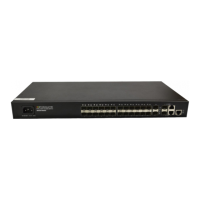Basic System Configuration & Debugging
28.2.1.1 SNMP Operation Mechanism
SNMP can be divided into two parts, namely, Network Management Station and Agent:
Network management station (NMS) is the workstation for running the client program. At
present, the commonly used NM platforms include QuidView, Sun NetManager and IBM
NetView.
Agent is the server software operated on network devices.
The NMS can send GetRequest, GetNextRequest and SetRequest messages to the Agent.
Upon receiving the requests from the NMS, Agent will perform Read or Write operation
according to the message types, generate and return the Response message to the NMS.
Agent will send Trap message on its own initiative to the NMS to report the events
whenever the device status changes or the device encounters any abnormalities such as
restarting the device.
28.2.1.2 SNMP Versions
Currently SNMP Agent of the device supports SNMP V3, and is compatible with SNMP V1
and SNMP V2C.
SNMP V3 adopts user name and password authentication.
SNMP V1 and SNMP V2C adopt community name authentication. The SNMP packets
failing to pass community name authentication are discarded. The community name is used
to define the relation between SNMP NMS and SNMP Agent. The community name can limit
access to SNMP Agent from SNMP NMS, functioning as a password.
You can define the following features related to the community name.
Define MIB view that a community can access.
Set read-only or read-write right to access MIB objects for the community. The read-only
community can only query device information, while the read-write community can configure
the device.
Set the basic ACL specified by the community name.
28.2.1.3 MIBs Supported by the Device
The management variable in the SNMP packet is used to describe management objects of
a device. To uniquely identify the management objects of the device in SNMP messages,
SNMP adopts the hierarchical naming scheme to identify the managed objects. It is like a tree,
and each tree node represents a managed object, as shown in Picture 28-1. Thus the object
can be identified with the unique path starting from the root.

